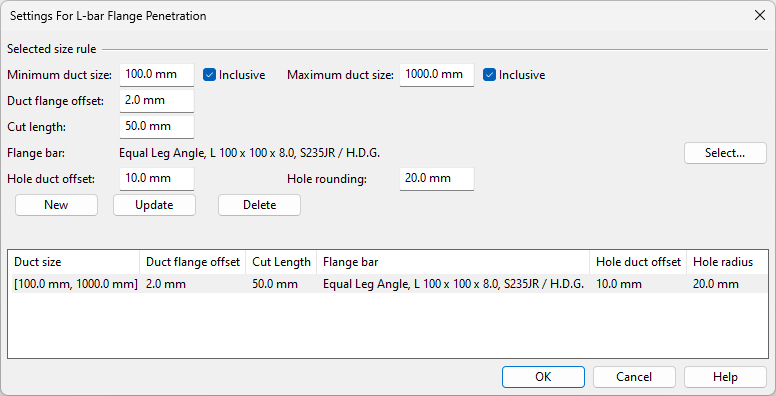Duct penetration settings
In [project] > Specifications > Construction > Duct Penetration Settings, the project administrator can manage the settings that generate the required parts when a duct penetration is inserted into the 3D model.
The settings define, for example, which duct sizes will use the settings, how much space to leave between the duct and the hole, and what materials to use for constructing the penetration.
When a designer is inserting a duct penetration to a bulkhead or deck plate in the model, the designer can select which settings to use, as described in Penetration.
Defining duct penetration settings
You can define settings for generating a duct penetration into the 3D model.
Do the following:
-
In the Project Environment dialog, go to [project] > Specifications > Construction > Duct Penetration Settings.
-
Select New > Construction Settings.
-
You are prompted to select the penetration type.
- Flange using L-bars inside hole
- Flange using L-bars outside hole
- Flange using flat bars
- Flange using flat bars and doubler
Select the required type, and then click OK.
-
Enter a name and description for the settings object. Ensure that these provide enough information for the designers to select the appropriate settings for each penetration.
-
In the Settings For… dialog, create rules for the selected penetration type. For example, you might have one rule for duct sizes that can use a smaller flange bar, and another rule for duct sizes that require a larger flange.
-
To add a rule, define the rule settings:
-
Minimum duct size, Maximum duct size – Specify the range of duct sizes that will use this rule.
If Inclusive is selected, the rule also applies to ducts whose side length exactly matches the specified value.
-
Duct flange offset – Specify the distance from the outer side of the duct to the reinforcing flange around the opening.
-
Cut length – For the 'Flange using L-bars' type, specify how much to cut away from the duct piece inside the penetration, or leave this to 0.00 mm to indicate that the duct will not be cut.
The cut length is measured from the middle of the width of the L-bar, in the direction away from the angle where the legs of the L-bar meet.
-
Flange bar – Select the material to use for the flange bar.
-
Doubler bar – For the 'Flange using flat bars and doubler' type, select the material to use for the doubler bar.
-
Hole duct offset – Specify the distance from the outer side of the duct to the side of the hole.
-
Hole rounding – Specify the radius for rounding the corners of the rectangular hole.
Then, click New. The new rule is added to the rule list.
-
-
To modify a rule, select the rule from the list, edit the settings, and then click Update.
-
To delete a rule, select the rule from the list, and then click Delete.
-
-
When all required rules are specified for this penetration type, click OK to close the penetration settings editor.
